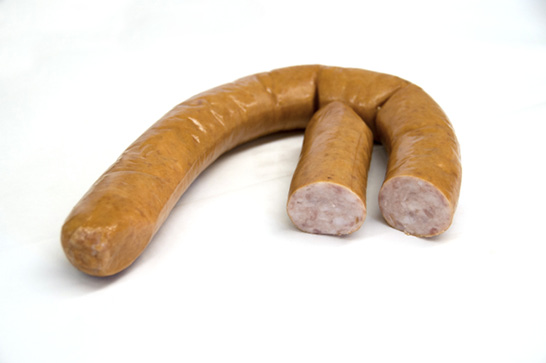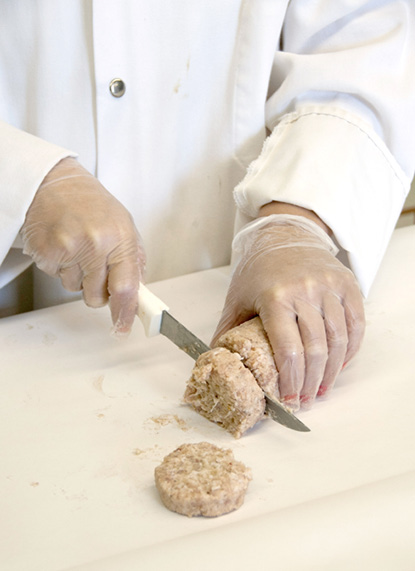Making Sausage at Home
Making sausage at home can be a fun way to explore new seasonings and flavors in the convenience of your home. Sausage flavorings can vary from original to cheesy, spicy, hot, and Italian-based spice blends. Sausage can be formed as patties or links and made fresh or smoked. Sausage can be made from any kind of meat like pork, veal, beef, poultry, venison, or a blend of any of these meats. This publication provides a simple sausage seasoning recipe and lists the basic steps for easy and safe sausage-making.


Pork Sausage
When making pork sausage, use only fresh, good-quality raw materials. Good-quality materials are non-frozen, boneless pork trimmings with lean muscle and some fat. These must be no more than 5 days old, and they must have been kept at 40°F or lower.
Always be careful when handling the meat to avoid bacterial contamination. Follow good hand-washing techniques, and thoroughly clean and sanitize utensils and equipment before using them.
Usually trimmings are used to make sausage; however, often shoulders, hams, and/or loins (usually from sows) are boned for this use. The proper mixture is two-thirds lean and one-third fat, but you can change the ratio to your liking. Below is a popular recipe for pork sausage:
- 16 lb meat (2/3 lean, 1/3 fat)
- (e.g., 10.7 lb lean, 5.3 lb fat)
- 10 tbsp salt
- 10 tbsp black pepper
- 2 tbsp red pepper
- 4 tbsp sage
- 4 tbsp sugar
- ½ lb water (optional)
Equipment needed
- Scales and mixing container
- Sharp knife
- Clean, sanitized, smooth, nonporous surface on a table for handling product
- Grinder with four-blade knife and plates (as described below)
- Stuffer with horn or stuffer attachment for grinder (if stuffing into casings for smoking)
- Casings for smoked sausage (as described below)
- Freezer paper, tape, freezer bags, or plastic tubes (chubs), and ties to close bags
- Freezer set to 0°F or lower
- Smokehouse for smoking sausage in casings
- Means to hang smoked links for smoking, if desired
Grinding
Sausage-making begins with grinding. Cut the lean and fat into small pieces to go into the grinder. It is important that the meat is chilled to approximately 32°F to minimize fat smearing. Sausage meat should be kept cold throughout the process. First, grind the meat through a grinder using a one-half to three-fourths-inch plate initially. Then, mix the meat with the seasonings in a mixer, with a paddle blender, or by hand. Be sure the seasonings are thoroughly mixed with the meat, and then re-grind the seasoned meat through a three-sixteenths-inch grinder plate. These basic principles are the same for most types of sausage or blends; however, the spice recipe may need some modifications for other blends or if the sausage meat is not predominately pork.
Casings and Stuffing
Sausage can be stuffed into casings that are natural, fibrous, or muslin. Opaque plastic bags are also used to stuff sausage chubs (for fresh sausage like breakfast patties). Casings are usually narrow- or medium-diameter sheep casings, natural pork casings, or collagen casings.
Natural casings preserved in salt should be soaked in lukewarm water for 30 minutes before use. Then run cold water through the casings to remove excess salt. Fibrous casings are permeable to smoke and moisture and can be removed after smoking/cooking and before packaging, final preparation, and consumption.
It is important during stuffing to force as much of the casing onto the stuffing attachment (horn) as possible. Hold each casing firmly between your fingers on the stuffing horn. Use enough pressure to fill the casing fully so that there are no air pockets in the encased sausage.
Curing
Sodium nitrite, or cure, is used in some sausage formulations at 156 parts per million, based on total meat weight. Cure is essential to inhibit the growth of Clostridium botulinum. In addition, it gives sausage its characteristic pink cured color and improves flavor.
Commercial cure products/seasoning blends can be purchased from some specialty stores, seasoning manufacturers, local meat processors, or butcher supply outlets. It is very important to follow the directions on the package. Cure is used routinely in smoked sausage products, but it is usually not used in fresh sausage products.
Smoking
Smoking meat extends the product shelf life and adds a smoky flavor and appearance. If curing sausage (using sodium nitrite), the blended sausage should be allowed to cure for about 24 hours before smoking.
Sausage should be dried on the surface and smoked at a smokehouse temperature of no more than 90–95°F for 3 days (on and off) until the desired color is attained. Usually you can get the desired color by continuously smoking for 10–16 hours. For on and off smoking, it will probably take 1–3 days (be sure internal temperatures are kept cold). Smoked pork sausage, properly cured and packaged (air tight, with protection from freezer burn), will keep up to 6 months in a freezer at 0°F or lower.
Fresh Pork Sausage
Fresh pork sausage may be packaged immediately after the final grind and must be refrigerated or frozen. Fresh (non-frozen) sausages should not be held in the refrigerator for more than 3 days and should be cooked thoroughly (160°F internal temperature) when served. If properly packaged (see above description), fresh pork sausage (non-stuffed and non-smoked), should maintain good quality for 2–4 months in a freezer (0°F or less).
Safety
Remember it is important to handle all products and equipment with care and cleanliness. Keep meat cold (40°F or lower) during grinding and mixing. Make sure you wash your hands and keep all work areas clean.
While there are few to no reported cases of trichinosis today, eating raw or undercooked pork or wild game carries a potential risk for infection. It is important to cook all sausage products thoroughly to an internal temperature of 160°F to avoid exposure to other potentially harmful bacteria.
References
Graham, P., Marriott, N., & Kelly, R. (2012). Dry curing Virginia-style ham. Virginia Cooperative Extension Food Science and Technology, Virginia Polytechnic Institute, Blacksburg, Virginia.
Ray, F. (n.d.). Meat curing. Unpublished manuscript, Oklahoma Cooperative Extension, Oklahoma State University, Stillwater, Oklahoma.
Richmond, W. L., & Shannon, J. W. (1977). Publication 399: Country Style Hams, Bacon and Sausage. Cooperative Extension Service, Mississippi State University, Mississippi State, MS.
Romans, J., Costello, W., Carlson, C., Greaser, M., & Jones, K. (2001). The meat we eat. Danville: Interstate Publishers, Inc.
United States Department of Agriculture, Food Safety and Inspection Service. (2016). Ham and food safety.
United States Department of Agriculture, Food Safety and Inspection Service. (2013). Sausages and food safety.
The information given here is for educational purposes only. References to commercial products, trade names, or suppliers are made with the understanding that no endorsement is implied and that no discrimination against other products or suppliers is intended.
Publication 2692 (POD-09-23)
By J. Byron Williams, PhD, PAS, Associate Extension Professor, Central Mississippi Research and Extension Center, and Courtney A. Crist, PhD, Assistant Extension Professor, Food Science, Nutrition, and Health Promotion.
The Mississippi State University Extension Service is working to ensure all web content is accessible to all users. If you need assistance accessing any of our content, please email the webteam or call 662-325-2262.



